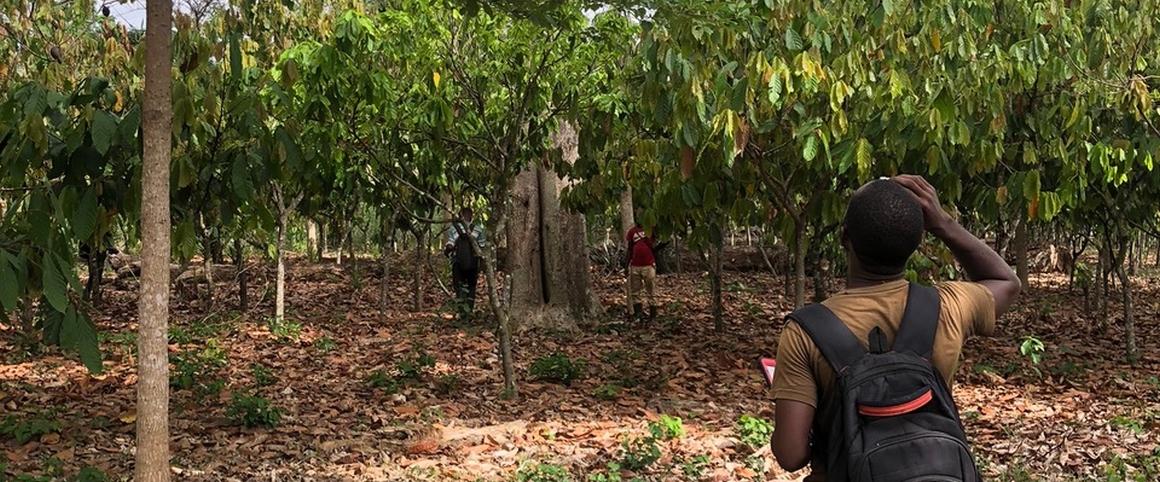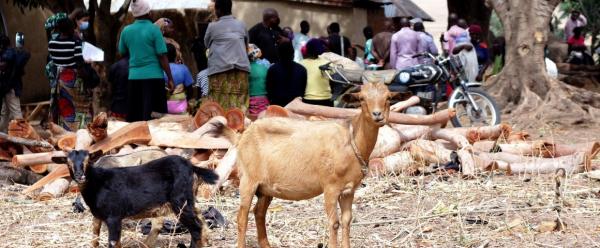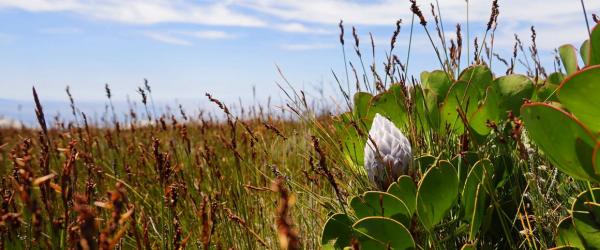Results & impact 28 October 2025
- Home
- CIRAD news
- News
- Natural tree regeneration in cocoa-based agroforests
Cocoa and agroforestry: betting on natural tree regeneration

An inventory of some 12 000 trees has been conducted in more than 150 cocoa plantings across Ivory Coast © B. Hérault, CIRAD
A Franco-Ivorian team has conducted a massive inventory of more than 12 000 georeferenced trees in 150 cocoa plantings across Ivory Coast, as part of the DeSIRA (Development Smart Innovation through Research in Agriculture) project, Cocoa4Future, funded by the European Union and the Agence française de développement. Of the trees recorded, 20% were intended to be used for timber, in other words for the materials they produced, rather than burnt like fuelwood. Those trees are therefore a potential significant economic resource for cocoa producers working in agroforestry systems.
Where did those trees come from? "In our collective imagination, cocoa plantings are obviously highly controlled environments: people think that the trees in agroforestry systems have been planted by farmers", says CIRAD's Bruno Hérault, a forest ecologist. "However, as observations of cocoa plantings in Ivory Coast show, that is not generally the case."
Bruno Hérault oversaw the inventory of more than 240 hectares of Ivorian cocoa plantings, and the results obtained. According to those results, around 70% of the current timber resource in those plantings came from remnant trees, in other words trees that were already in the forest before the cocoa trees were planted on the land. The scientists went as far as estimating the future resource: 77% will most probably come from trees that have grown spontaneously within existing cocoa plantings.
These results cast doubt on the efficacy of current tree planting programmes, whether public or private. "In Ivory Coast, reintroducing trees into cocoa plantings is being encouraged by means of extremely costly, ambitious programmes", Bruno Hérault explains. "More than 10 million trees have already been distributed or planted, at a cost of more than 5 billion CFA francs (more than 7.6 million euros). However, a lot of those trees are dying, either because they were not actually planted or were not planted under the right conditions, while others, often of the same species, grow wild nearby."
Relying on natural dynamics to ensure more resistant trees
The small percentage of planted trees in the current and future timber resource is notably due to "planting shock". According to Aimé Kouassi, a PhD student at the Institut National Polytechnique Félix Houphouët-Boigny and lead author of the study, "In West Africa, many trees first build their root system to be able to withstand the dry season. In nurseries, on the other hand, trees begin their growth under good conditions, and therefore do not develop as much of a root system. This triggers a shock when they are planted out in cocoa plantings under field conditions, and most of them either die or vegetate".
Without writing off these programmes, the scientists involved in the study highlight the need for technical support and plantation monitoring. Above all, they are calling for complementarity with other approaches, notably natural regeneration of the trees already in cocoa plantings.
"Spontaneous trees are often highly resilient, and have a good chance of developing correctly with little technical support", Bruno Hérault affirms. Of almost 2500 timber trees identified, three quarters had in fact "grown on their own".
Financial and policy support is required
The results of the study are encouraging those funding planting programmes to divert part of the available funding to support natural regeneration practices, which are less costly and more effective. However, the scientists also point out the crucial role of policymakers in ensuring that the forestry code is applied correctly.
In Ivory Coast, the forestry code was amended in 2019, notably to guarantee farmers' rights over the trees in their fields, whether wild or planted. Over and above that protective framework, the effective transfer of ownership is taking its time, which significantly affects farmers' ability to commit to agroforestry and help regenerate forest cover in the country, from 9% today to 20% by 2030.
Reference
Aimé K. Kouassi, Irié C. Zo-Bi, Raphaël Aussenac, Isaac K. Kouamé, Marie R. Dago, Anny E. N'guessan, Patrick Jagoret, Bruno Hérault. 2023. The great mistake of plantation programs in cocoa agroforests – Let's bet on natural regeneration to sustainably provide timber wood. Trees, Forests and People 12 : 100386



























